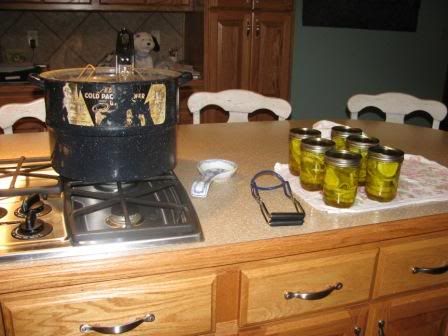Those kind of objects don't tempt me to spend a lot of money, but homesteading gadgets and gewgaws do. When I saw this lovely seed starting set-up from Gardener's Supply Co., I nearly started to salivate.
 |
| 3-Tier Sunlite Garden, sold by Gardener's Supply Co. |
We attempted to start some of our vegetable plants from seed last year and had mixed results. The main problem was that the plants got leggy due to lack of adequate light. This doodad would completely eliminate that problem. There's room to start quite a few seedlings or nuture larger transplants and the level of the light fixtures is easily adjusted.
There's just one problem. The Sunlite Garden costs $599, shipping not included. Ridiculous, isn't it? No worries. You can create your own, even larger version of this set-up for a fraction of the cost.
Here's how we did it:
Materials List:
- One 74"x 48" 5-Tier Shelving Unit - $79.97 at Lowe's
- Four 48" T8 fluorescent shop lights - $17.98 each at Lowe's
- One 12 pack of 4' T8 Cool White Fluorescent bulbs - $29.98 at Lowe's
- Eight S-hooks - 78 cents for two at Lowe's
- One power strip with timer
- $13.98 at Amazon.com
GRAND TOTAL FOR HARDWARE: $198.97 plus tax
 |
| We assembled the shelving unit and then hung the shop lights from each shelf |
I found out from my research that you don't have to use special lights to grow strong seedlings. A standard fluorescent light will work provided that you can adjust it so that it is 1-2" above the seedlings. Shop lights already come on 9" chains; all you have to do is buy a few S hooks to hang them from the shelving unit at the level you need. Seedlings need about 12-14 hours of light a day and a power strip on a timer makes it easy to provide the right amount of light while saving energy.
 |
| The level of the shop lights can be easily adjusted using the chains and S hooks |
Other expenses: You will also need something to start your seeds in. You can buy sterile seed starting medium or make your own. We plan on recycling toilet paper and paper towel rolls for seed starter pots (read about how to do that here) and milk jugs for larger transplants, so those will be free. We invested in some leak-proof seed starting flats, clear domes to cover the flats during germination, and a couple of heat mats to use with the most heat-loving plants.
We'll be starting our first seeds in less than a month. I can't wait to put this system into use! I think I'll take all the money we saved and buy something truly useful.... like more chickens!
Reference:
Best Tips for Starting Seeds Indoors by Barbara Pleasant in the Dec 2012/Jan 2013 issue of Mother Earth News
--------------
Anyone else starting seeds indoor this year? What kind of set-up do you employ?




















